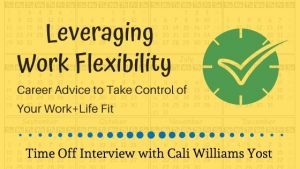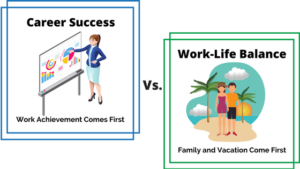Work-life balance benefits vary greatly from employer to employer. You want to win a job that moves your career forward and hopefully pays more money, but what about time off benefits and flexibility?
There are no work-life balance standards either by law or by industry in the US. That makes it difficult to determine if a job you are applying for brings work-life-vacation balance or work-work-work balance. What can you do to find out if work-life balance is a company priority BEFORE you apply for a job and accept a job offer?
VacationCounts is proud to present these job listing web search tricks to determine work-life balance benefits without alerting HR to your preference for life and vacation over work.
Searching for a Job with Work-Life Balance
First ask yourself if you are seeking a job that offers unlimited vacation days, flex-time plans, accelerated vacation accrual, or simply just sensible working hours so you can have your evenings and weekends free. Your job search task is to discover companies that can fulfill your work-life-family, work-life-hobby, or work-life-travel needs.
Online job listings explain the role and responsibilities quite well. They often describe working conditions and company benefits in general, but work-life balance is usually left out. Asking a hiring manager about balance, especially before you are even offered a job, is not the best way to demonstrate that you are a hard-working, dedicated employee.
So what can you do to find out if a job opportunity offers a healthy work-life balance before you apply or after receiving an offer of employment? Here are our top 7 ways to search for clues to work-life-vacation balance at any job opportunity.
1. Corporate Website
The first place to look is the official website for the corporation or organization. It doesn’t matter if the job listing was found on an Internet search job board such as Monster.com, Indeed, or Career Builder. As is evident in these advanced job search screenshots, there is no way to filter results by vacation days, job flexibility, or work-life balance benefits. So you must go to the source.

Browse to the company website and make sure that you are on the corporate site and not the consumer oriented one. For a multi-national or diversified company, try to find the website for the corporate entity that applies to the job posting. Benefits are not always equal across different branded and affiliated companies. For a foreign company with a U.S. division (or vice versa), the benefits mandated by law will most certainly be different.
On the company website look for a link that says “Work For Us”, “Careers”, “Job Openings”, or simply “Employment.” Browse that section and look for documents and especially videos that talk about company culture and what it is like to work there. This type of HR communication will give you a sense of the work-life balance. However since the information is meant to highlight only the positives, take it with a grain of salt.
2. LinkedIn
LinkedIn is a treasure trove of information on companies, employees, and business happenings. If you are not already using LinkedIn for your job search, you are missing out on one of the most effective ways to be discovered for new career opportunities. Once you have your profile, job history, and connections set up, use the site as a professional networking search engine.
The first place to turn is your connections. Look for people who worked for a specific company and send them a message with your work-life balance questions. After that seek out 2nd and 3rd level connections (friends of friends and so on) for help. In order to contact these individuals that currently or in the past worked for a prospective employer, you will need to forward your request through your own network. Be personal and direct in your request to pass along a message through a direct connection.

Since a large percentage of people have their LinkedIn profile set to public, you can also search for people who are not connected to your network who have worked at a particular company. While it may not be possible to reach out and contact them if you don’t share connections, you can still scan their job experience to look for work-life balance clues. You may discover that the work environment is a stressful one or extra busy during certain times of the year. Alternatively you may read about a supportive environment where each employee is flexible and given the time off they deserve. Either way you can learn a lot.
Finally, LinkedIn has comprehensive company listings so you can search by business name and view a ton of details. This includes the names of employees, job listings, company news, product releases, and links to their website and social media networks. All of this is potentially useful during a job search.
3. Google
Googling for hits about work-life balance at a company is fast and effective. Try your search using a variety of keywords plus the name of the employer to review the useful results. Here are some examples of searches to conduct:
- [Employer] work-life balance
- [Employer] flexible working hours
- [Employer] vacation policy
- [Employer] family benefits
- [Employer] sabbatical
- [Employer] flex-time
- [Employer] PTO
- [Employer] vacation weeks
You may find unwelcome results as this example search shows how one company dropped its flexible work program.

Of course in a large corporation, the vacation policy may vary from department to department and be based on your seniority level or length of employment. So use this information as a reference point to determine where a company is on a work-life balance scale from bad to good. When you find clear evidence that work-life policies exist, there is a good chance that these benefits will be available to most full-time employees.
4. Twitter
Using Twitter during a job search can lead to all sorts of useful, amusing, and intriguing results, mostly because of the power and limitation of the medium. With only 140 characters to say something, tweets about a company are often cryptic. When a company name is mentioned in a tweet, it may be a rant, a request for help, or self-promotion. So how do you go about searching Twitter for work-life balance hints?
To search Twitter go directly to Twitter.com or your favorite twitter management app such as HootSuite. Try to find tweets from employees as you aren’t likely to get work-life balance details directly from the company’s tweet stream. However current employees may be more likely talk about the lack of work-life balance, probably more so than the presence of it. Search keywords and relevant hashtags to see what work-life signals rises to top.

Here are examples of work-life balance tweet types to pay attention to as warning signs.
- Working late on a weekend, especially on a Friday
- Being forced to come into the office on the weekend
- Leaving for vacation in a stressful or burnt out mood
- Cancelling a trip due to excessive work load
- Not being able to leave work for family obligations
- Saying haven’t taken a vacation day in months
- Complaining about losing unused vacation days
- Ranting about lack of work-life balance at the office
- Desire for flexibility in working days and hours
Of course you will find positive work-life balance tweets from happy employees too. Maybe they are bragging to their friends about how great they have it! I just believe it is easier to find negative signs which cause an employee to turn to Twitter to express their dissatisfaction.
5. Work-Life Balance surveys
Articles about work-life balance, vacation benefits, and flexibility in the workplace are published from time to time. National newspapers and news web outlets will discuss this issue and often mention companies by name. These articles are written for a wide-audience so the examples are mostly major employers that are familiar to readers. A regional newspaper may feature local places to work, so they may be a better source of work-life balance realities in your geographic area.
Work-life balance articles tend to be accompanied by statistics and recent survey information. Hopefully those stats come from current employees and not just the HR (or PR) department. They often rank order the “best” employers and jobs for work-life balance based on their own criteria. When you find a top 10 or top 50 or top 100 “Best Employers for Work-Life Balance” or “Best Places to Work” type article, pay attention. Those are the companies to consider if they have matching openings in your commuting radius or wish to relocate for a better job.
Consider setting up a Google email Alert for work-life balance articles and surveys so you can be reminded about the “best” employers if you want to maximize your time off.

6. Ask by Phone or Email
 When you are lacking information about work-life balance and flexible working conditions, you might have to go back to the source and ask. For large companies that have a sizable human resources department, finding the correct person to ask may be challenging. Start with the name in the job listing or look for the benefits hotline to call or email. Be cautious if you are still in the application or interviewing stage since you do not want to raise any red flags. While you may have work-life issues on your mind, consider including a few other benefits queries to balance out your line of questioning.
When you are lacking information about work-life balance and flexible working conditions, you might have to go back to the source and ask. For large companies that have a sizable human resources department, finding the correct person to ask may be challenging. Start with the name in the job listing or look for the benefits hotline to call or email. Be cautious if you are still in the application or interviewing stage since you do not want to raise any red flags. While you may have work-life issues on your mind, consider including a few other benefits queries to balance out your line of questioning.
LinkedIn can also be used to determine the right HR staff member who may be open to explaining work-life balance and flexibility in their corporation. Reach out to your network to get in touch with someone who can offer some insight, whether they are in Human Resources or any other department.
When an outside recruiting firm or an external recruiter posted the job, you may wish to contact them directly with your questions. Since the recruiting team can be extremely busy during hiring times, craft a succinct email or place a timely phone call. As this person does not work directly for the company they may lack the full picture or exaggerate. However they may be able to talk more freely if you are nice and respect their time. Either way be cautious when gathering work-life benefit information from outside sources.
One more idea is to call the telephone sales or customer service line and speak to a live employee. I’m not suggesting that you pretend to be a customer or sales prospect. However you can often get a feel for the level of stress, helpfulness, and work attitude by talking with employees on the front line. Avoid asking personal questions as you do not want to put that person in an awkward position. Just be honest and say that you are applying for a job and wanted to learn more about the company. Listen then thank the person for their time.
7. Other Job Listings
The job you wish to apply for may not mention flexibility and vacation benefits, but maybe other jobs at the same company do. Search the company website or job board for more openings in other departments and regions to read through. See if they offer additional signals about work-life balance or the lack of it. While they might not apply to the exact opportunity you are seeking, it at least is a valid indication about corporate culture.
Summary
I hope you’ve learned some valuable lessons for figuring out the work-life-vacation balance at any company. The tools of web search, job boards, company websites, and social media can all lead to valuable facts and opinions on working conditions and company flex benefits. So before you apply for that next job and after you’ve received an offer, search and evaluate work-life fit as part of your decision making. You won’t regret taking the time to seek the best jobs which meet your work-life balance and paid time-off goals.






